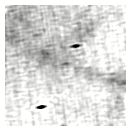|
The resolution possible with HIRES depends on source strength, coverage, and background complexity. Following are some rules of thumb for choosing good HIRES targets. The source should be "sufficiently bright"Unresolved sources should be brighter than about 1 Jy, extended sources brighter than about 2 MJy/steradian. Also, the local signal-to-noise ratio should be fairly high (~10 or greater), in order to avoid complications in baseline subtraction and to help ensure high spatial resolution. On the other hand, HIRES can sometimes help in the detection of faint sources by pulling them out of the cirrus background. HIRES can sometimes reveal sources that are not in the Point Source Catalog (PSC) or the Faint Source Catalog (FSC). Below 1 Jy, the results depend strongly on background complexity. Example:
. . . but not too brightVery bright sources (> 1000 Jy) may suffer from artifacts such as hysteresis, saturation and optical crosstalk.The target should have good detector coverage.HIRES will work over most of the sky; however, its achieved resolution is variable, depending, among other things, on the amount of coverage. It is desirable to have both a large number of scans and variation of the scan direction. The number of scans available depends in part upon the number of hours-confirmed coverages (HCONs) the source received. Most of the sky has three HCONs of survey coverage. Since IRAS was in a near-polar orbit, the coverage varies with latitude. Higher ecliptic latitude regions are also more likely to have variation in the scan direction. A good target should be covered by two HCONs of survey data or by at least one Additional Observation (AO). The number of HCONs of coverage can be found in the PSC, all of whose sources have at least two HCONs. In general, more coverage is better, but eventually calibration uncertainties dominate. More information can be gained about the coverage of a given nearly point-like target by processing it with SCANPI. SCANPI is the one-dimensional coadder; it also produces detector scan track plots within a 4' window of the input position. Return to HIRES Instructions . | ||||||



